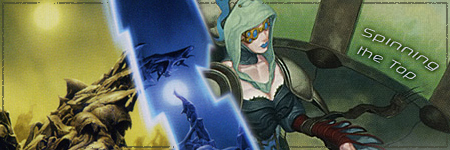
Spinning the Top: Meet the Multiplayers
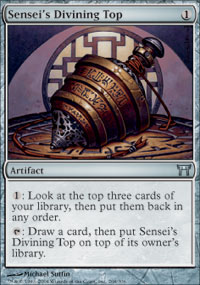
We should definitely play this card...
Multiplayer Magic, as I'm sure many of you are aware, is a term that is usually used to refer to Magic games of more than two players (though I have heard of certain tournament formats with frequent opponent changes referred to as "sequential multiplayer" but let's not go there now, tis a silly place.) Now that I've gotten my mandatory Monty Python quote out of the way I would like to talk seriously about how multiplayer Magic differs from more traditional dueling, and how you can both win games and win friends in the process.
I play at least 95% of my Magic in multiplayer, and it has just as complex and interesting a metagame as any tournament scene out there. You can apply the same levels of focus and time to playing good, solid multiplayer as you can to top-eight-ing a PTQ, and yet many otherwise serious players avoid/don't succeed in multiplayer. I believe that this originates in three major differences in the nature of the game, which lead to five major deck building changes, which when combined properly will allow both the freshest newbie and the seasoned PTQ hunter to get what they want out of Magic "down time."
Multiplayer Differences to Think About
Now, the first, most obvious difference between your even your laziest, most casual FNM and the hardest-core multiplayer group is that you need to do more than 20 damage. This means that the ability of a deck to squeak out narrowly-tuned wins by getting exactly to 21 will not prove victorious or enjoyable in multiplayer Magic. This can have dramatic effects on deck design (Hint: Burn decks need to play some very particular cards to work) or some slightly smaller ones (Erratic Explosion needs to become Kaboom!). Just like mana curve and the need for a fair deal of speed dominate the concerns of deck designers for dueling, this difference is the dominating maxim for the construction of successful multiplayer decks. The number of opponents will continually be a factor that needs to be consciously considered in all of our further progress towards deckbuilding.
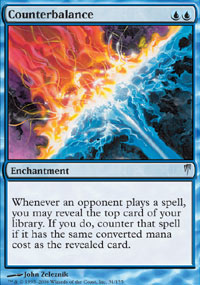
...but its teammate stays home when
playing with seven friends.
The third major variance is probably the easiest for veterans to understand, it but gets fresh players all the time. In an eight-man game, you can't have more resources than all your opponents combined. In Standard you may play mana ramp and be used to having mana advantage over your opponent, but no multiplayer deck can do more than seven opponents combined. This leads to some well-tuned, seasoned control decks drowning in multiplayer on the simple basis of too much to do every single turn. This rule will mainly help us adjust our play style, but it will also keep us away from certain deck designs that don't really take all opponents into consideration. A deck like All in Red, which in Extended can make use of its blistering speed to lock an opponent out, is always going to be a bridesmaid in multiplayer. A turn one Deus of Calamity keeps only one opponent out of the game, and then someone else, who has land you've never touched, simply Wraths it away - and suddenly you have an empty hand, you've killed no one, and at least one player is very, very angry with you.
Recommendations for Winning More Multiplayer:

Say no to cards that only generate tempo
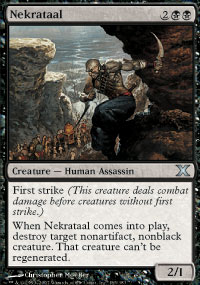
187s are some of the best creatures
in multiplayer

There are somethings this can do
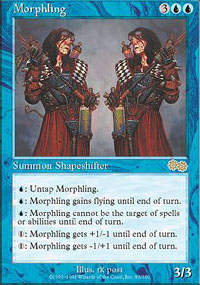
That even Superman can't
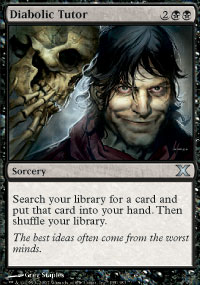
He's smiling because he's winning
5. Appreciate Recursion. As I've talked about extensively above, almost all multiplayer games are going to get out of the early game, and usually make it to what would usually be considered the extreme late game by duel terms, for at least for a couple of the decks at the table. The game will be played to accumulate card advantage by way of the board by at least a couple of the decks. With this in mind, you can start to imagine that any cards that allow you to make use of expended resources again begins to have an appeal, both in virtual card advantage and in simply providing more things to do. Wrathing away a Genesis and a Mullrifter doesn't have quite the same appeal as Wrathing away two Psychatogs. Whenever you get this sort of free cards it allows you to gain advantage over your opponents without spending any cards at all; it allows you to keep your cards in hand to continue to deal and react with new events. The ability to selectively choose the resources you acquire can lead to spectacular blowouts where you simply get everything you need every time. Cards like Genesis and Oversold Cemetery allow you to strike your foes even when your resources have been consumed by normal game play and would otherwise be out of play for good. As a result, you'll seldom see a good multiplayer deck with absolutely no way to take advantage of these expended results.
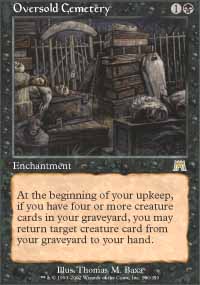
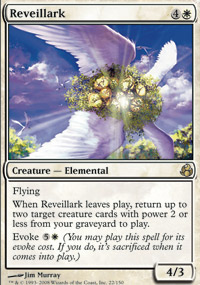
These cards are even better on turn 20.
Ideas in Action
To demonstrate some of these ideas I've built a little bit of a demo deck that is built along these lines. It's not the most powerful deck of all time, not even the most powerful multiplayer deck at most tables, but it has a certain level of fun and exciting plays that can impress a table while keeping you in the running for winning the game. You'll notice the deck is not super expensive, but at the same time I haven't shied away from some expensive cards that really help the concept flow.
| B/W Intro to MultiplayerMagic OnlineOCTGN2ApprenticeBuy These Cards | |
|---|---|
|
Lands (23): 4 Godless Shrine 2 Urborg, Tomb of Yawgmoth 4 Fetid Heath 4 Terramorphic Expanse 5 Swamp 2 Plains 1 Cabal Coffers 1 Mikokoro, Center of the Sea Creatures (18): 2 Dread 1 Akroma, Angel of Wrath 2 Mindslicer 3 Nekrataal 3 Reveillark 2 Karmic Guide 1 Pristine Angel 1 Knight-Captain of Eos 2 Stillmoon Cavalier 1 Myojin of Night's Reach | Spells (19): 3 Demonic Tutor 2 Consume Spirit 2 Wrath of God 1 Austere Command 1 Damnation 2 Sensei's Divining Top 3 Syphon Mind 2 Oversold Cemetary 2 Vindicate 1 Leyline of the Void |
I'd just like to review a couple of the card choices and how they relate to the ideas we discussed:
Syphon Mind may be the best multiplayer black card ever printed. It does some universal hand damage without too much mana, but usually draws you at least three cards. So a black Concentrate that comes with "discard three cards" is simply too good to pass up. When playing Swamps in multiplayer, Syphon Mind should be played.
Vindicate is the perfect definition of flexibility and toolbox universality. Really cheap, too. The only downside is sorcery speed, which ties up your mana (that's more important for a board control deck in multiplayer) but it's worth it. The advantage to this over Oblivion Ring, which seems a lot cheaper, is that someone will blow away enchantments at some point in a long game, and that scary baddy showing back up is never fun, especially now that the resource to deal with it has been expended.
Oversold Cemetery is really, really good late game in this deck in bringing back any number of creatures over the course of turns. It may not activate very fast in this deck, which is the reason for only packing two and counting on the Top and Demonic Tutor to find them.
Karmic Guide and its echo really likes Oversold Cemetery - Zombify and a blocker every turn? It really plays well in this deck, and protection from Terror is not to be scoffed at. You are much more likely to have this creature still be around as the blocker you thought it was going to be when you cast it.
We have a "big play" suite in Akroma, Dread, and the Myojin. Pristine Angel is fun with its pseudo-vigilance and high level of protection, which can help you delay the deployment of your Wraths, Vindicates, and Nekrataals until you are sure that a creature is really a threat to you in particular.
Urborg, Cabal Coffers, and Consume Spirit combine to form a cool little combo that you can really use for instant late game reach-and-wins.
The above part of the deck can deal with recursion, delay, and make some big plays these last cards form the toolbox part:
Demonic Tutor is obviously the best tutor every printed. It's not too expensive, and if you play in casual formats where you can run them, I wildly recommend a playset. It's very, very good on turn two, and not bad at any point after that.
Sensei's Divining Top provides great card selection and occasionally card draw that otherwise wouldn't be in the deck. Divining Top sees an amazing amount of play in larger games, as the lost tempo of one, two, sometimes three mana a turn poured into the top doesn't set us back too far.
Leyline of the Void allows you to make a four-drop that can simply tell some opponents that they are not playing this game with their full deck. Heavy recursion decks will see this card on turn one (once in a while, obviously) and just be down half their game plan from the get go. And, if you need it right now, Demonic Tutor is happy to oblige.
This deck isn't fully tuned but it can be really fun to mess around with. The first time you Wrath a Lark into the yard and it brings out Stillmoon Cavalier and a Karmic Guide that brings the Lark back, you'll feel a little dirty bit of fun. Wrathing over the head of the Myojin and then pulling the counter can make you feel on top of the world, and gives you the large plays to sit down against almost any multiplayer deck.
Good luck and have a good game!
-RogueNewb
Comments